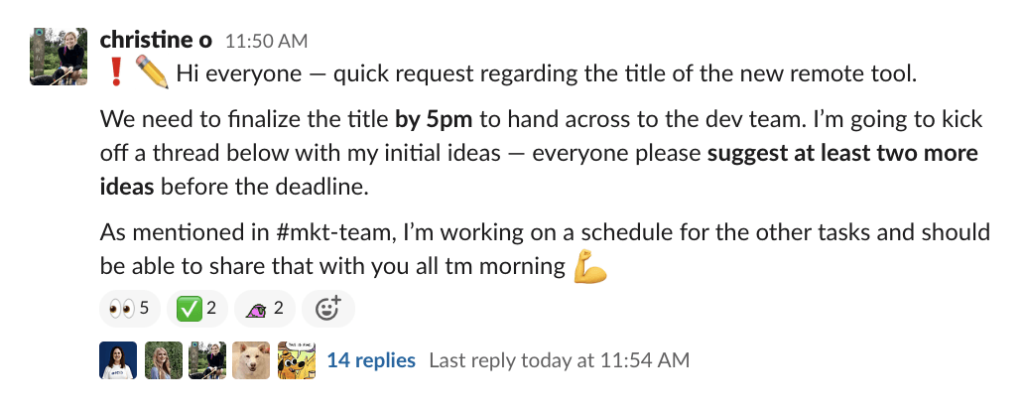If you’ve ever found yourself sending a message like this:
Hey, have you had a chance to check out the document I sent you this morning?
…this guide is for you. The reality is: when you’re not sitting next to the people you’re collaborating with, communication gets trickier.
So how does our team communicate with messages to keep work flowing even from half a world away? Read on!
Looking for top talent fast? See how Arc can help you:
⚡️ Find developers, designers, marketers, and more
⚡️ Freelance or full-time remote + fully vetted
⚡️ Save up to 80% with global hires
Hire top talent with Arc risk-free →
The Biggest Challenge of Remote Collaboration
The Arc team is distributed across multiple continents and time zones. This gives us enormous flexibility and strength as a team, but also raises a couple of challenges:
- Sometimes our team members move from being co-located with us to the other side of the world — so no more just turning our chairs around to explain things!
- Not all of our team members have the same native language, so clarity of written communication is critically important
As a remote-friendly team, we’re always looking to optimize our processes so we can work together more effectively.
While Arc has developed shared communication guidelines (e.g., which Slack channels to use for different topics), each team also has its own guidelines. For Arc’s marketing team, we use Slack for short messages and quick task requests (e.g., editing/proofreading requests).
Unfortunately, we found that marketing team members were becoming blocked due to a lack of clarity, which slowed us down.
We decided to solve this by improving our written communication. One of the fastest, but most effective, solutions to improve our Slack communication was using a series of standardized emojis.
Read More: How to Integrate Freelance Software Developers Into Your Current Team
What Standardized Slack Emojis Do We Use?
We default to written communication because we are remote-optimized, whether we’re debating an idea or editing a document.
A lot of written communication.
To help us distinguish signal from noise, we place standardized emojis in front of a self-written message, or as a reaction to someone else’s message.
Check out our standardized emoji key below (we keep this in our marketing team Notion, and also pinned to our main marketing channel in Slack).

Read More: How to Create a Software Development Workflow for Freelance Hires
Faster and Better Remote Collaboration with Slack Emojis
Team communications are exactly that: communications optimized for sharing information as a team. We all have different preferences and methods of sharing our ideas — but when you’re collaborating with others, you need to try to empathize with your teammates’ preferences as well.
Words or images: which do your teammates prefer? When it comes to collaborating over Slack, our standardized emoji system means you don’t have to choose — they get both.
Aside from agreeing on a set of emojis to use, and what these emojis mean to us as a team, we also have some more guidelines for posting “action required”-type emojis in our Slack channels. Request messages also need to include:
- A description of the required action
- Any relevant information/documents
- A deadline for the action
Here’s an example of how we use this system:

It’s also understood within our team that:
- Emojis aren’t mandatory — they only get placed in front of messages if this will assist with clarifying the meaning of the message
- More than one emoji can get used if this helps communicate your request/status — e.g., if you use❗to indicate urgency, you can also use another emoji to show what action needs to be taken
- We can still use any other emojis we feel like using, as long as they don’t confuse the meaning of the message — because we are not giving up our doge emoji any time soon!
Read More: 10 Ways to Avoid Failed Software Projects & Why They Fail to Begin With
Standardized Slack Emojis Improved Our Remote Collaboration
We found that using emojis as “intention signals” in our written messages (or as reactions to other peoples’ messages) helped us by:
- Clarifying the meaning of messages and actions
- Quickly telling your team member what you are asking them to do/what you have done
- Letting people know that you have seen their message and/or are working on their request
- Enabling asynchronous team members to catch up on other team members’ task progress at a glance
Overall, we found that these emojis not only helped us to notify actions and timeframes for task requests, but they also assured us that messages had been seen/actioned without needing to constantly follow up with each other about task status.
The result? Reduced confusion and smoother workflows within the team.
We hope this guide helps your team collaborate more effectively. How does your team communicate via instant messaging platforms? Let us know in the comments below!
You can also try Arc, your shortcut to the world’s best remote talent:
⚡️ Access 450,000 top developers, designers, and marketers
⚡️ Vetted and ready to interview
⚡️ Freelance or full-time








